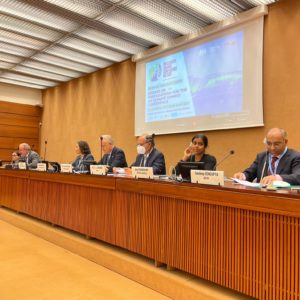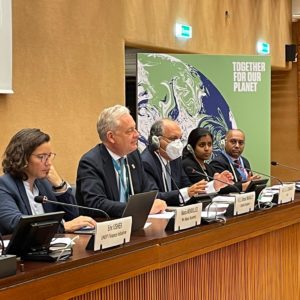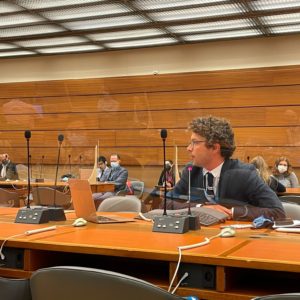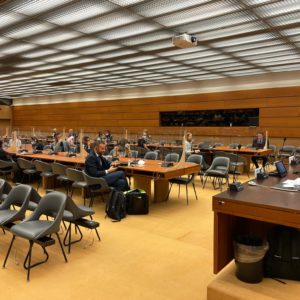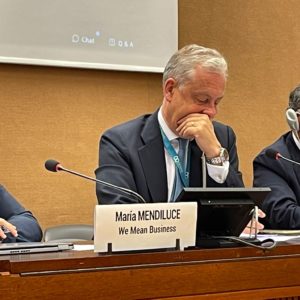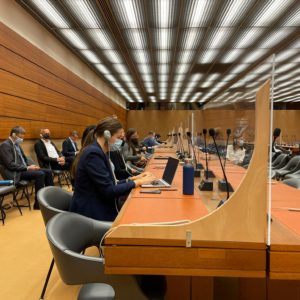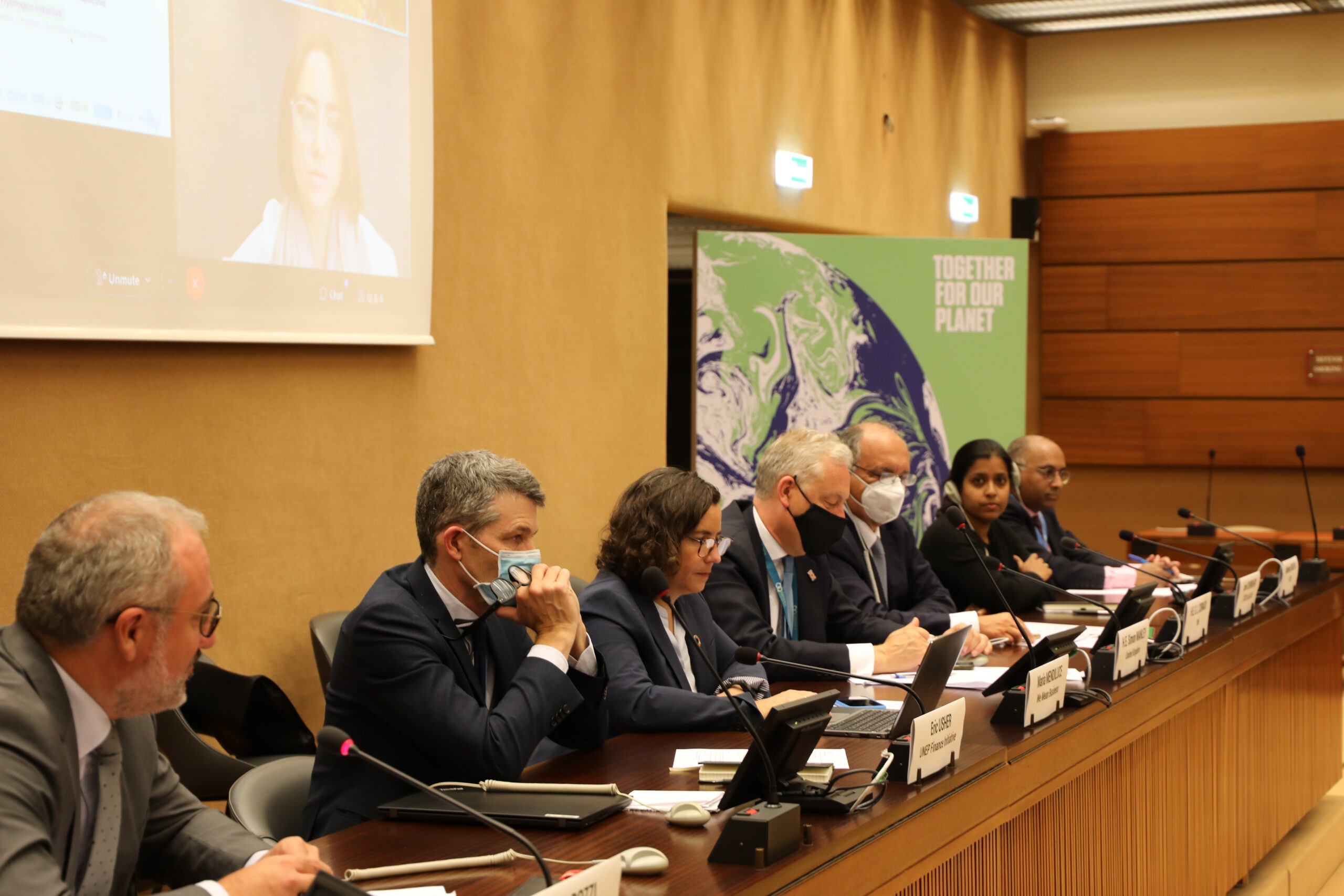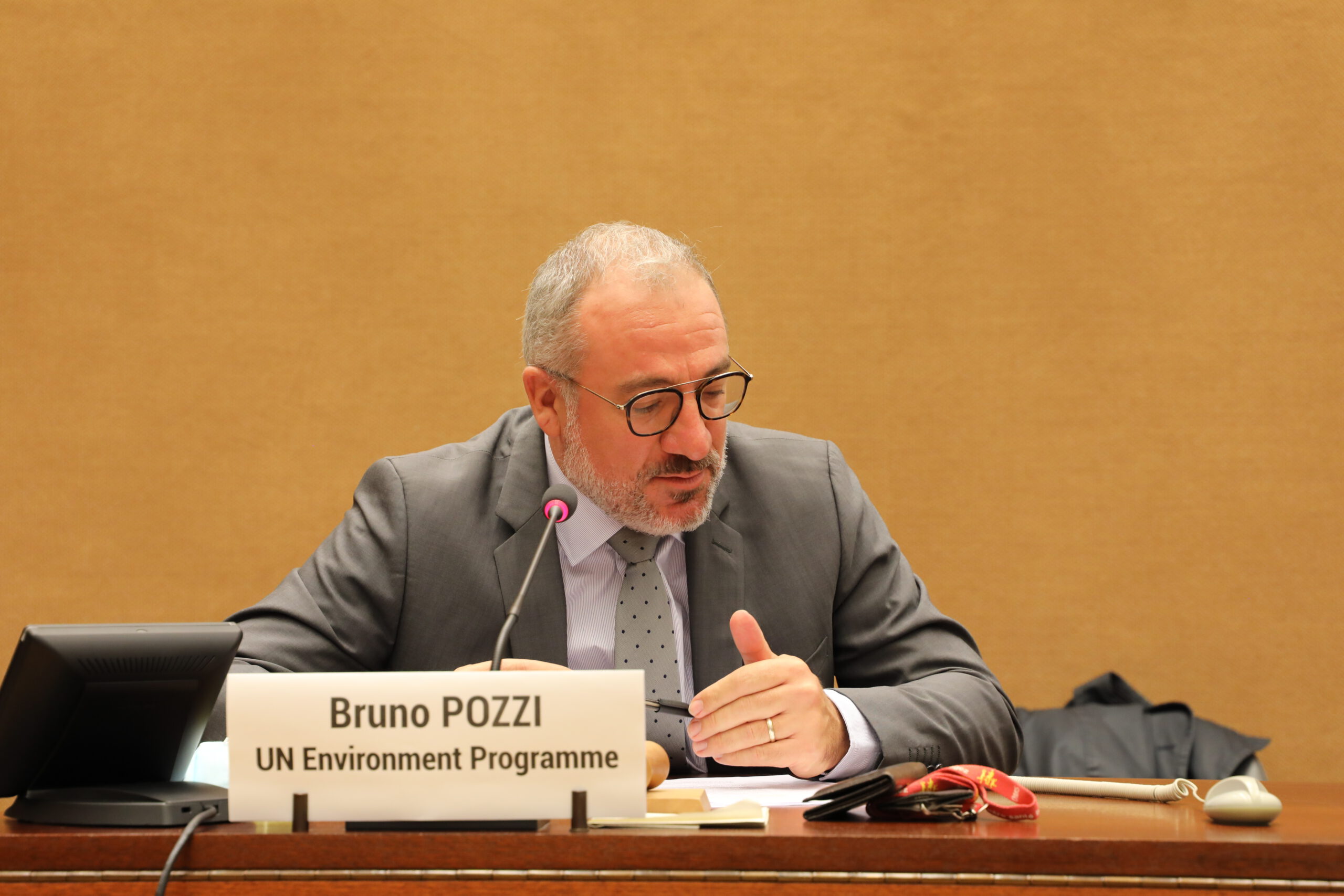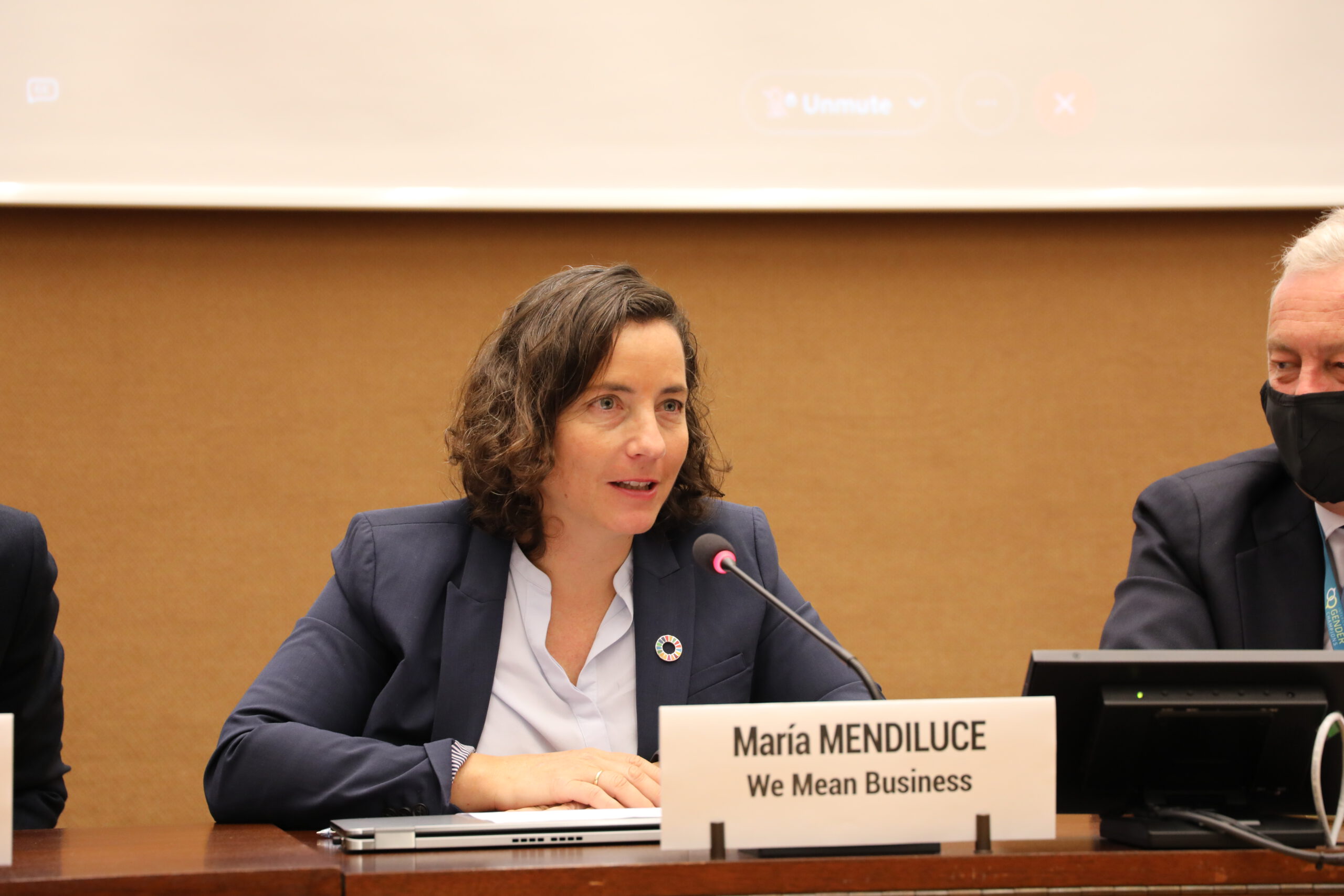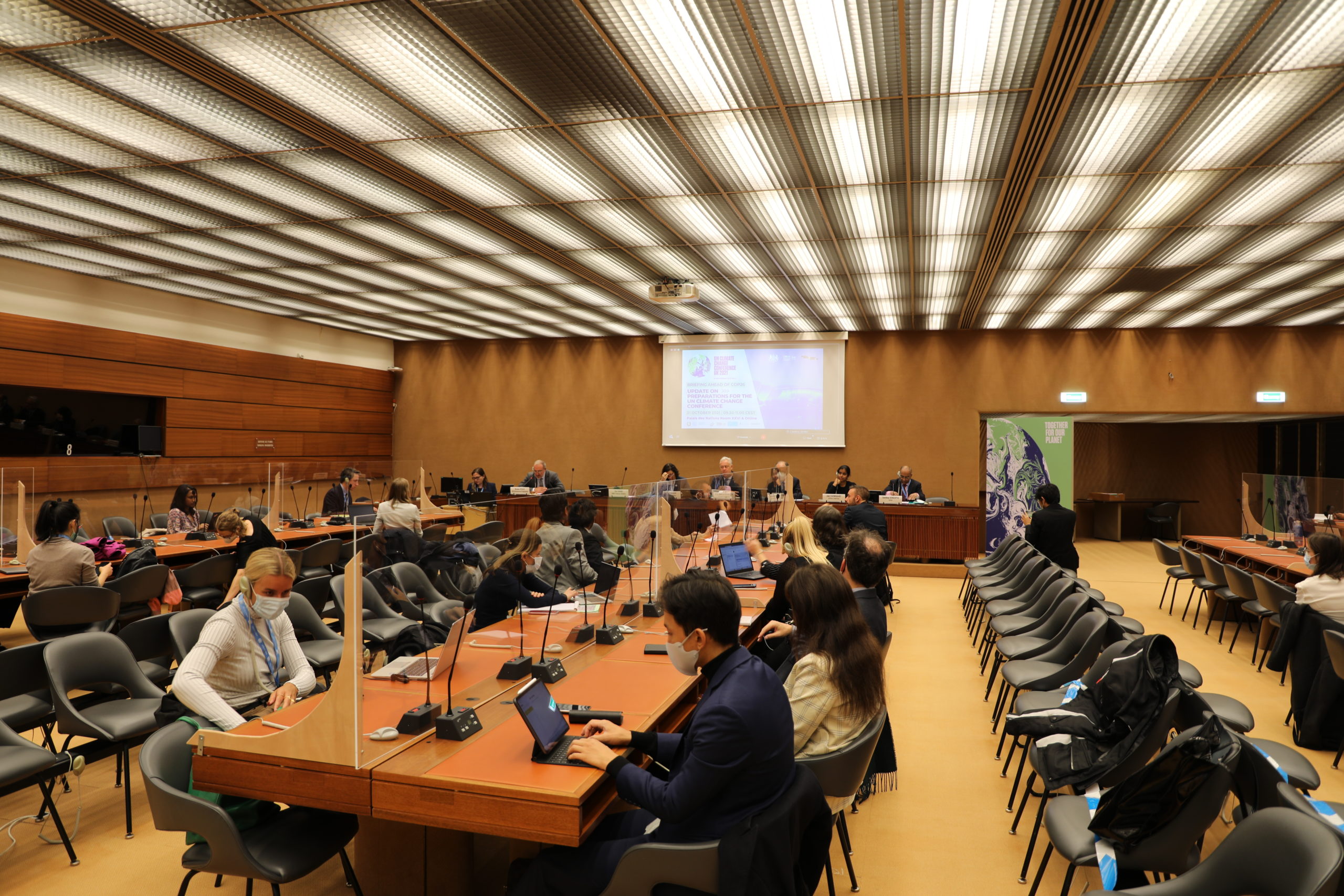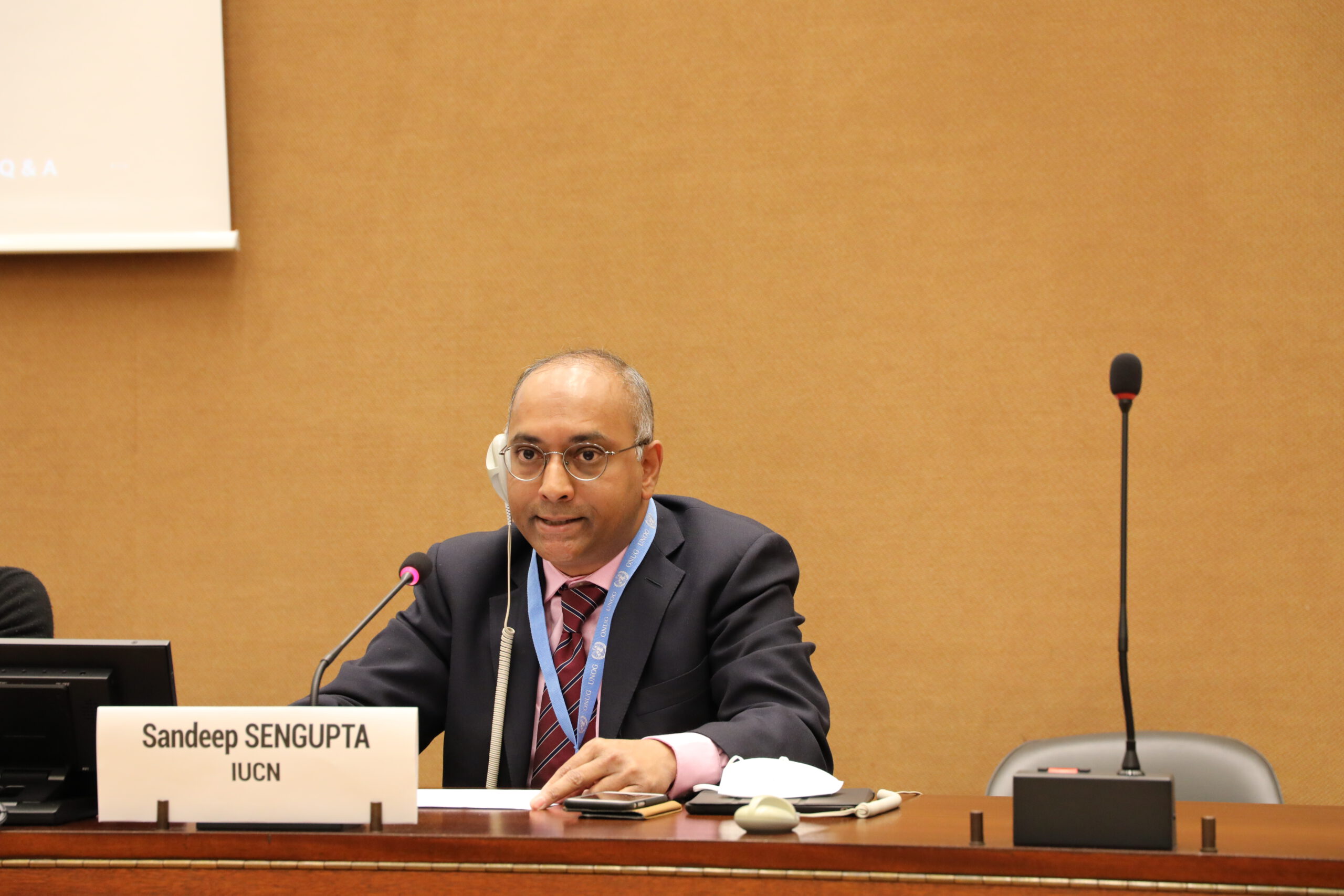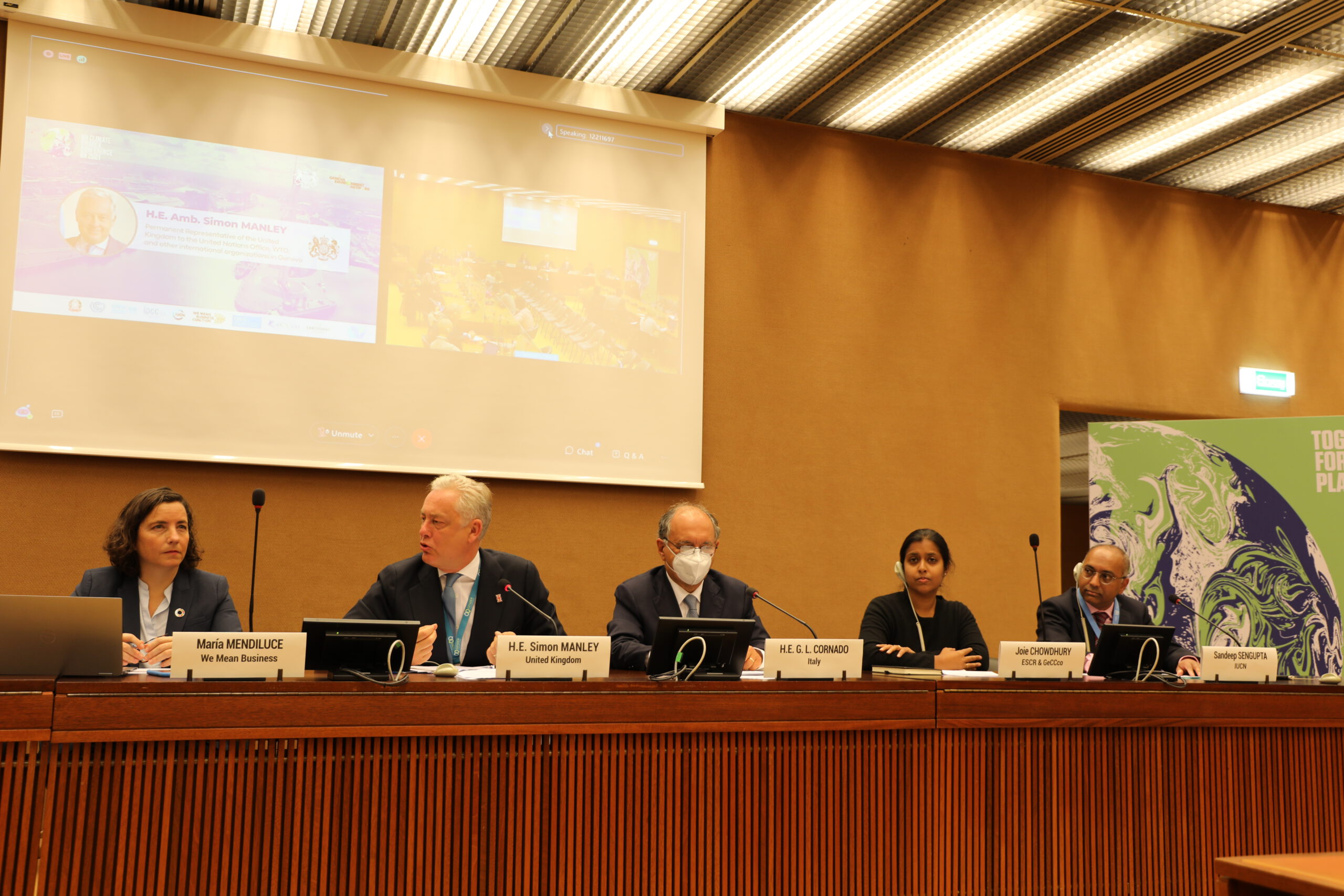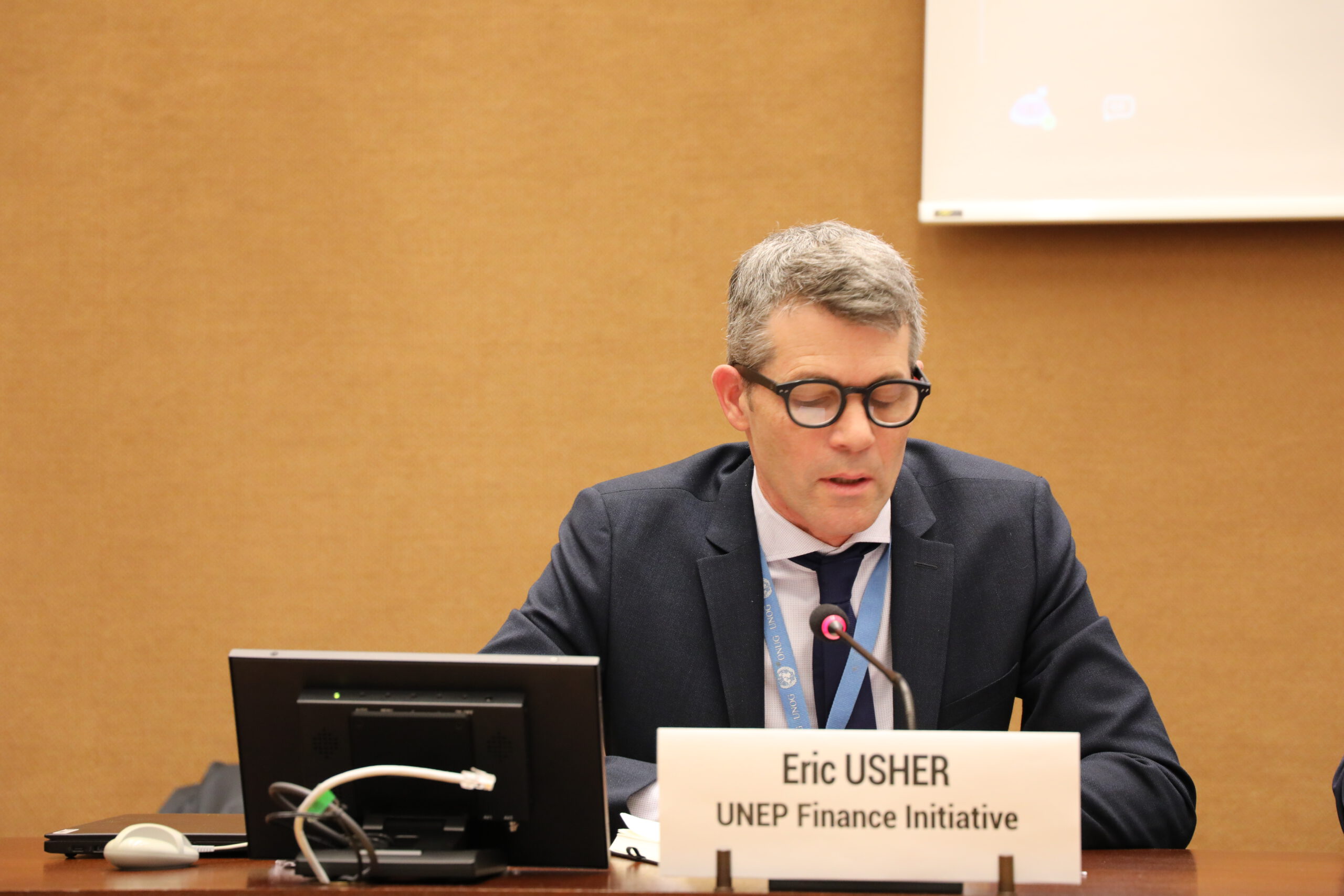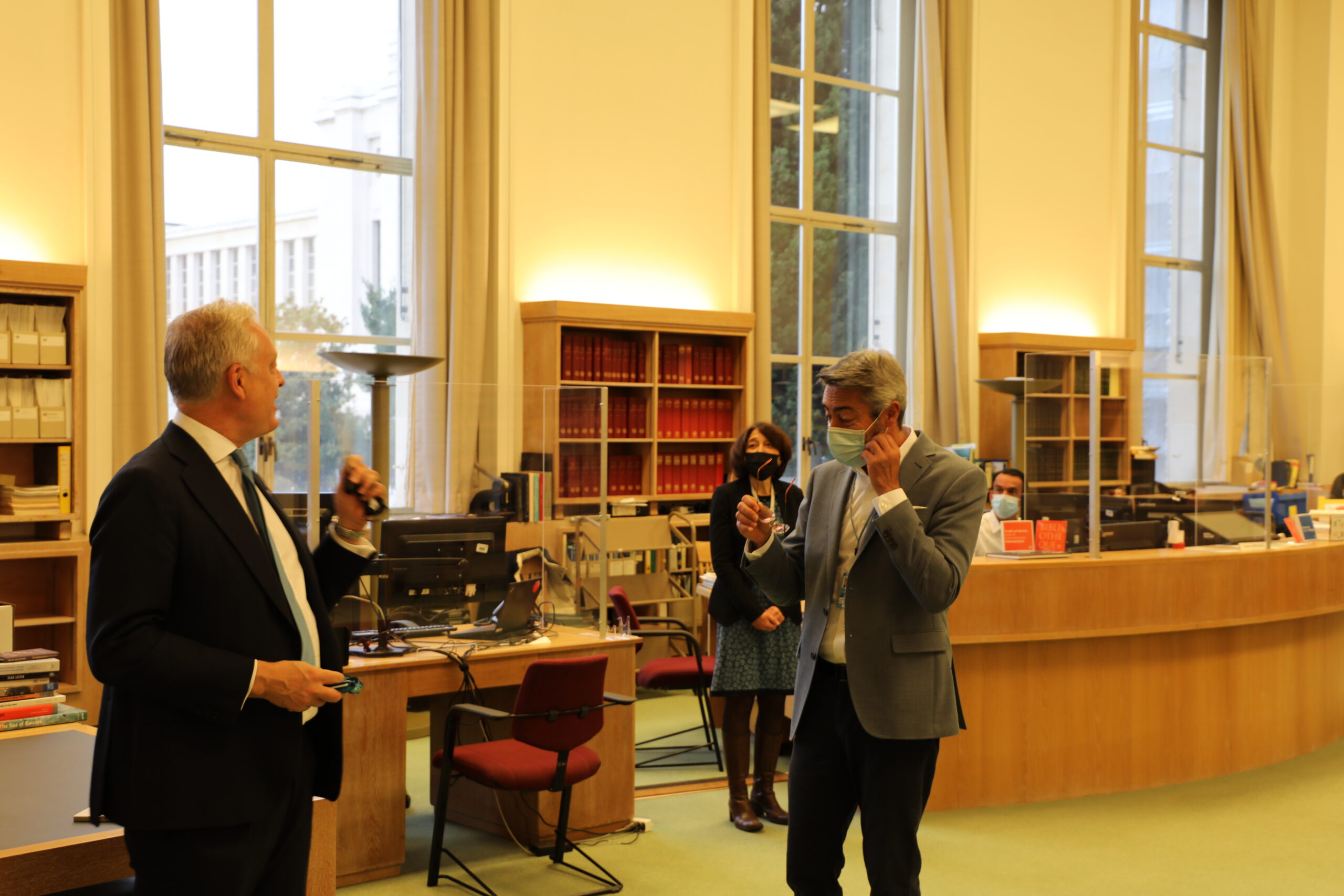Event Conference
Update on Preparations for the UN Climate Change Conference | Briefing Ahead of UNFCCC COP26
The United Kingdom Permanent Mission to the United Nations Office and other international organizations in Geneva joined the Geneva Environment Network for a briefing on the opportunities and challenges to addressing climate change ahead of the 26th meeting of the Conference of the Parties to the United Nations Framework Convention on Climate Change (UNFCCC COP26), to be held in Glasgow, Scotland, from 31 October to 12 November 2021.

![]()
About the Session
Heads of state, negotiators, experts, and campaigners will soon gather in Glasgow at the 26th UN Climate Change Conference of the Parties (COP26) for the most consequential climate conference since the Paris Agreement. As the leading climate science body laid out in stark terms, the world is ‘dangerously close’ to running out of time to stop a climate change catastrophe.
COP26 will focus on accelerating progress towards achieving the aims of the Paris Agreement. To avoid the worst effects of climate change, countries must ramp up ambition, accelerate adaptation, increase international climate financing, and collaborate across governments, businesses, and civil society to finalise the Paris rulebook.
Speakers from various facets of the climate agenda laid out what to expect from the conference. They shared their insights on the political dynamics, negotiations, and how to take forward the progress to be made in Glasgow to the implementing arm of international climate action in Geneva. The event also presented one of the Earthshot Prize Finalists, which was announced on 17 October 2021.
Speakers
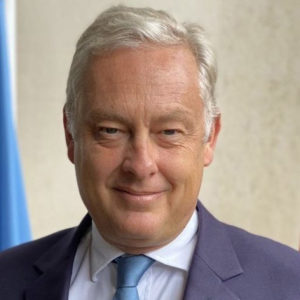
H.E. Amb. Simon MANLEY
Permanent Representative of the United Kingdom to the United Nations Office, WTO, and other international organizations in Geneva

H.E. Amb. Gian Lorenzo CORNADO
Permanent Representative of the Italian Republic to the United Nations Office and other international organizations in Geneva

Ovais SARMAD
Deputy Executive Secretary, United Nations Framework Convention on Climate Change

Valérie MASSON-DELMOTTE
Co-Chair, Working Group I, IPCC

Sandeep SENGUPTA
Global Coordinator, Climate Change Portfolio, IUCN

María MENDILUCE
Chief Executive Officer, We Mean Business

Eric USHER
Head, UN Environment Programme Finance Initiative

Joie CHOWDHURY
Program Coordinator, Environment & ESCR, International Network for Economic, Social & Cultural Rights (ESCR)

Vaitea COWAN
Cofounder of Enapter, one of the winners of the Earthshot Prize 2021

Bruno POZZI
Director, Europe Office, UN Environment Programme | Moderator
Summary
Welcome
The UK Presidency of the 26th Conference of the Parties to UNFCCC (COP26)
- H.E. Amb. Simon MANLEY | Permanent Representative of the UK to the United Nations Office, WTO, and other international organizations in Geneva

- We face a turning point for humanity. As our Prime Minister put it in New York, we all know the science is compelling and we see now all too clearly perhaps, tragically, the real-world effects of climate change.
- There can be no doubt about the scale and immediacy of the challenge and the responsibility that we and Italy have to deliver a successful COP26 in Glasgow to ensure that we can deliver on the ambition that we set in Paris six years ago and that we can reach this target of keeping climate change within 1.5°C.
- We recognize the scale of the effort that we need to undertake as hosts, along with Italy – the collaboration with governments, civil society, business and the media to explain what we’re doing, why we’re doing it, and the part we can all play in ensuring that we achieve the targets we’re trying to achieve in Glasgow.
- It is about ensuring that we implement that sense of ambition that we set ourselves in Paris such as the mitigation and adaptation measures. To ensure that we fulfill that commitment, we need to set ourselves USD 100 billion of climate finance every year between 2020 and 2025.
- We need to enable countries to make the transition and to ensure that they address the vulnerabilities that are being caused by climate change. In our own net-zero plans, we need to change the way we generate the energy we use. We need to get off our dependence upon coal, be more ambitious, and phase it out by 2030. Cows are an enormously important source of methane, one of the most damaging greenhouse gases, and we need to find new and more sustainable ways of agriculture. It’s also vital that we end and reverse the deforestation of our planet, important in terms of biodiversity and vital as a carbon sink.
- It’s important to recognize technology. In the UK, we’ve been able to grow as an economy while reducing our carbon emissions. Over the last 30 years, our economy is growing by 75 and our emissions have fallen by 44, not least through the enormous investments that we’ve been putting into sustainable energy. It’s doable but requires the political will of governments and the actions by individual businesses and consumers to make this change.
- To ensure that Glasgow is not the end of a process but the beginning of this extraordinary transition that we have to go through to avoid breaching that 1.5°C limit, Geneva has a really important role to play. Geneva is the implementing arm of this climate effort. Each and every head of a UN organization or other international organizations I meet in Geneva talks about climate as probably the biggest issue they face whether in terms of trade, health, migration or refugees. We are working together here in Geneva for a successful COP and can play a crucial role in ensuring that we deliver on what we agree in Glasgow. The task is ahead for us and we look forward to seizing it and making success of it.
Developments from Pre-COP Milan
- H.E. Amb. Gian Lorenzo CORNADO | Permanent Representative of the Italian Republic to the United Nations Office and other international organizations in Geneva

- Italy, in its capacity as co-chair of COP26, hosted the pre-COP Youth4Climate Summit last September in Milan where 400 young leaders from the world were able to present their proposals for tackling climate change – reducing inequalities, involving young people in the decision making processes, and encouraging a public-private aid program were just some of the proposals that came out of the meetings.
- The Youth4Climate summit approved key messages and structures around four pillars: involvement in the decision-making process; sustainable recovery (an urgent, diversified and inclusive energy transition by 2030 and nature-based solutions); alignment of the private sector’s current and future operations, including their supply chain, to zero emissions; and, a climate conscious society with pledges for ministers of education and environment to support climate change education and youth empowerment.
- These recommendations were presented by young representatives of the Youth4Climate summit at the opening day of the pre-COP and discussed with over 50 ministers, members of the UNFCCC Secretariat, presidents of the subsidiary bodies of the Convention and civil society actors. The final document of the summit will be released on 24 October and will be presented in Glasgow.
- We have to face this transition in an equitable and inclusive way, which includes the poorest countries, the most fragile, and youth. We cannot imagine doing anything in this field without their participation in the decision-making process. For the first time, young leaders were allowed to present their recommendations during the pre-COP with a concrete follow-up in Glasgow. This inclusive approach has been an opportunity to hear their voices and to have a broader perspective that will foster innovative elements and new ideas for the future.
- For the preparative meeting in Milan from 30 September to 2 October, climate and energy ministers from more than 50 countries represented the major CO2 emitters, the most vulnerable, the most ambitious and regional constituencies to discuss and exchange views on key political aspects of the negotiations that will be addressed at COP26.
- The agenda for the pre-COP consisted of seven topics such as scaling up adaptation, loss, and damage, finalizing the Paris rulebook, mobilizing finance, and the adoption of new and ambitious NDCs. During the pre-COP, many saw the clear speed of collaboration, inspiring negotiations which will be helpful to find agreements in Glasgow.
- In a recent meeting in Rome to support the common effort towards a successful COP26, we mobilized all stakeholders – state and non-state actors. This is an issue closely linked to the need that the most developed countries keep their commitment to jointly mobilize USD 100 billion dollars a year by 2025 in favor of developing countries. This is an indispensable requirement for the successful outcome of the of the negotiations.
- An important task awaits at COP26 to ensure that concrete climate objectives will be set for the credibility our net-zero targets and the sustainability of the Paris Agreement. As for Milan, it gave the opportunity to those who will inherit our planet to voice their concern and give their perspective and concrete input.
Updates from the Secretariat
- Ovais SARMAD | Deputy Executive Secretary, United Nations Framework Convention on Climate Change (UNFCCC)
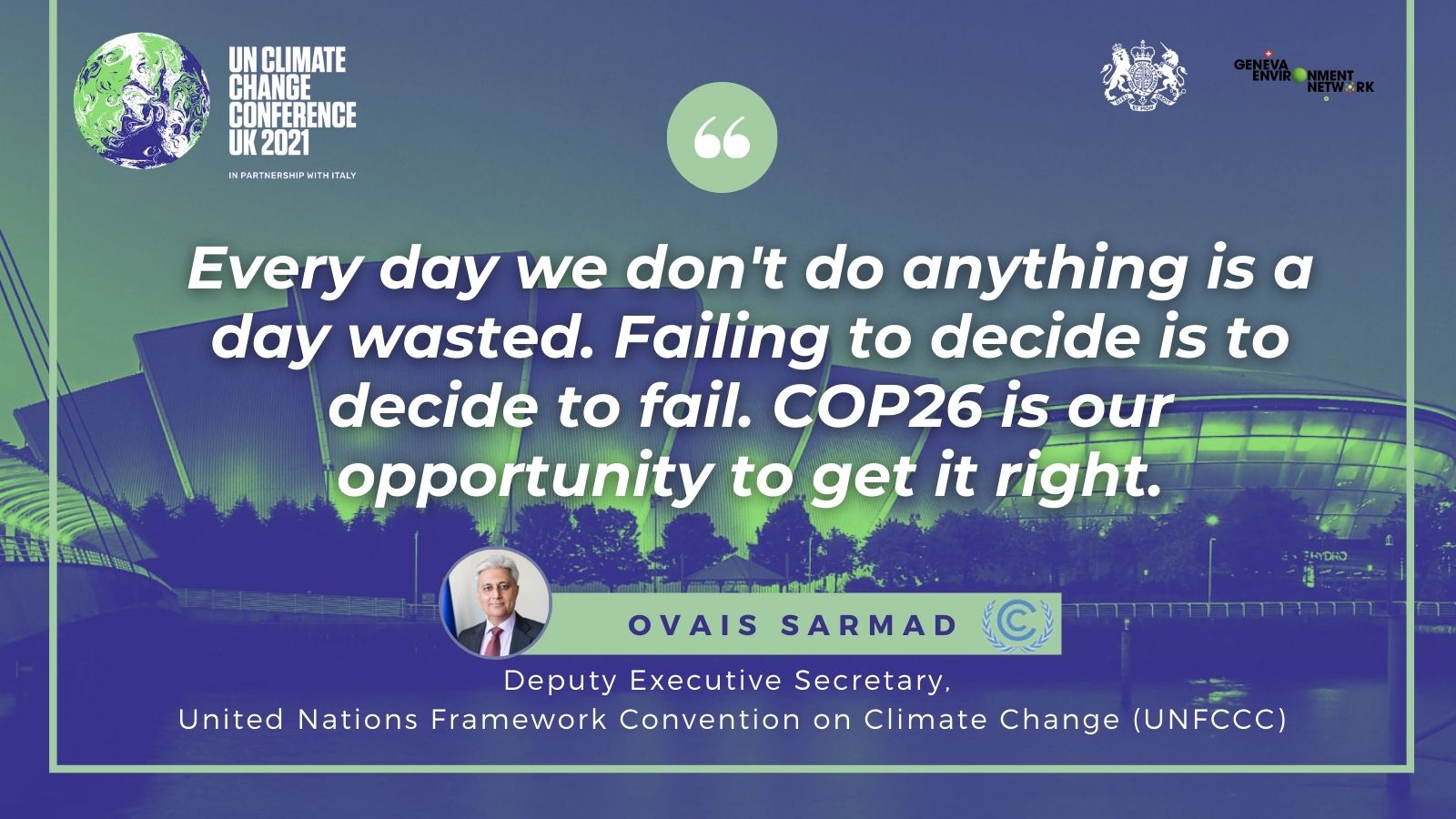
- COP26 is attracting huge attention from around the world, from all sectors of the society, to address something that we all know is an existential crisis we are facing. The expectations are huge, and, more specifically, to get back on track towards limiting global temperatures to 1.5°C.
- We are intensely working with our UK host and Italian co-host in Glasgow. More than 28,000 participants have registered and the number is growing every day, on par with what we experienced in Paris. We are also working intensely to provide a safe and secure environment for the conference in the midst of a pandemic.
- We have seen in the past two years since the outbreak of the coronavirus that emergencies are never restricted by borders, it is the same with respect to climate change. If we don’t take measures to deal with it today, especially at the COP and when we are often so focused on national interests and financial concerns, we will overlook to see the big picture. Climate change is the biggest long-term challenge of mankind. It impacts everyone, everywhere. Recently, we have seen extreme temperatures we have never experienced before.
- Now we have an opportunity to address the issue. The most recent IPCC report indicates that we need rapid, sustained and large-scale reductions of greenhouse gas emissions to limit the warming to 1.5°C. Our Secretariat also issued an NDC synthesis report. While some nations have strong national climate action plans, others need more or there will be considerable rise in global greenhouse gas emissions, projected to increase by 16% in 2030 compared to 2010. This is a code red for the planet, for mankind.
- COP26 represents a huge opportunity to mobilize all stakeholders to take action towards implementation and to address adaptation, mitigation, transparency of action and means of implementation. We have seen at the pre-COP in Milan strong and meaningful commitments.
- We need four key success at COP26. While agreements have been adopted, those need to be materialized and operationalized. Unfinished and pending items such as article six also need to be finalized to ensure progress on many other areas of climate action. In addition, national climate action plans and long-term strategies put forward by Parties have to be more ambitious to achieve climate neutrality by 2050. Furthermore, we must ensure that all voices are heard. Parties and non-body stakeholders need to collaborate in a spirit of inclusive multilateralism. A successful COP26 means positive engagement of observers and non-party stakeholders in taking action, especially civil society and the youth.
- We need to promote climate ambition globally. I invite everyone here today to use your contacts and influences to invite all to engage in climate activities. Every day that goes by without being able to implement the Paris Agreement is a full day of wasted inaction. Failing to decide may end up being the same as deciding to fail COP26. It is our opportunity to get it right. Geneva and its diplomatic community, especially the humanitarian community, has an extremely important role to play in this regard and I very much welcome your engagement and we are ready to help.
The Scientific Impetus for Action
- Valérie MASSON-DELMOTTE | Co-Chair, Working Group I. Intergovernmental Panel on Climate Change (IPCC)

- The key findings from the IPCC 2021 Climate Report reflects major science advances from multiple lines of evidence, observations, and insights from past climate understanding of the drivers and processes shaping the climate system changes.
- With insights from global and regional models, it’s a reality check where are we now. It’s now an established fact that human activities have warmed the atmosphere, ocean and land driving ice melt and leading to widespread rapid and intensifying changes. The magnitude and scale of current changes are unprecedented over thousands of years.
- If we look at the level of global warming, it’s now reaching 1.1°C over the last decade alone compared to the late 19th century. It is now unequivocal that all of this warming is human caused. The warming effect from heat trapping gases is dominated by our emissions of carbon dioxide and methane resulting from the use of fossil fuels, but also deforestation, agricultural and industrial activities, and waste. It’s partly masked by the cooling effect due to short-lived pollution.
- Human-caused climate change is affecting every region on Earth in multiple ways, strengthening the frequency and intensity of extreme events such as heat waves, heavy precipitation, droughts or fire. The slow components of the climate system need to adjust for decades or more. Glaciers need centuries and the deep ocean thousands of years. The sea level will continue to rise and the changes we are experiencing will increase.
- In this report, we consider five future emission scenarios ranging from very low, low- intermediate, high and very high. If greenhouse gas emissions remain close to today’s level, during just a few decades global warming of 1.5°C would be exceeded in the next 20 years to 2°C by the 2050s and 3°C in the next century. However, if rapid and deep reductions in carbon dioxide, methane and other greenhouse gas emissions are achieved in the coming years and continue decade after decade, global warming could remain close to 1.5°C and well below 2°C.
- In all cases, global warming of 1.5°C is expected to be reached in the next 20 years. Why does every increment of further warming matters? Many changes in the climate system become larger in direct relation to increasing global warming. This includes average temperature increase and precipitation change in every region, increases in the frequency and intensity of heavy precipitation, and hot extremes including harmful heat thresholds, droughts in some regions, the proportion of intense tropical cyclones as well as reductions in snow cover, permafrost and arctic sea ice.
- A warmer climate also intensifies the water cycle and its variability, including very wet and very dry climate events and seasons with implications for flooding and droughts. A warmer climate also affects the ocean in multiple ways that are important for marine life and people who depend on it. This includes intensified marine heat waves, loss of oxygen and ocean acidification. These multiple changes are more pronounced and widespread for every increase in future warming and can be stopped by limiting warming.
- Some consequences from past and future greenhouse gas emissions are irreversible over centuries to millennia especially sea level rise, which is already accelerating. Limiting warming would allow to slow and limit the scale of sea level rise, giving more time to adapt in low-lying coastal zone.
- The science is clear, CO2 emissions add to global warming. CO2 has a cumulative effect and, as a result, limiting human-induced global warming to any level requires limiting the total cumulative CO2 emissions. Reaching net-zero CO2 emissions as soon as possible, along with strong reductions in other greenhouse gas emissions, in particular, strong rapid and sustained reductions in methane emissions, would limit the warming effect.
- Declining aerosol pollution and methane would improve air quality. Reducing global greenhouse gas emissions would lead within a few years to discernible effects on atmospheric composition and improve air quality.
- The climate we will experience in the future depends on the decisions that we take now. I would like to flag that the latest scientific knowledge is available with a strategy of open science and open data to inform your choices to prepare for unavoidable changes and limits the scale of associated risks. For instance, using our interactive atlas, you can make your own maps, explore the synthesis of changes in climate characteristics that matter for impacts in your region, and access the underlying data.
The Role of Nature
- Sandeep SENGUPTA | Global Coordinator, Climate Change Portfolio, IUCN
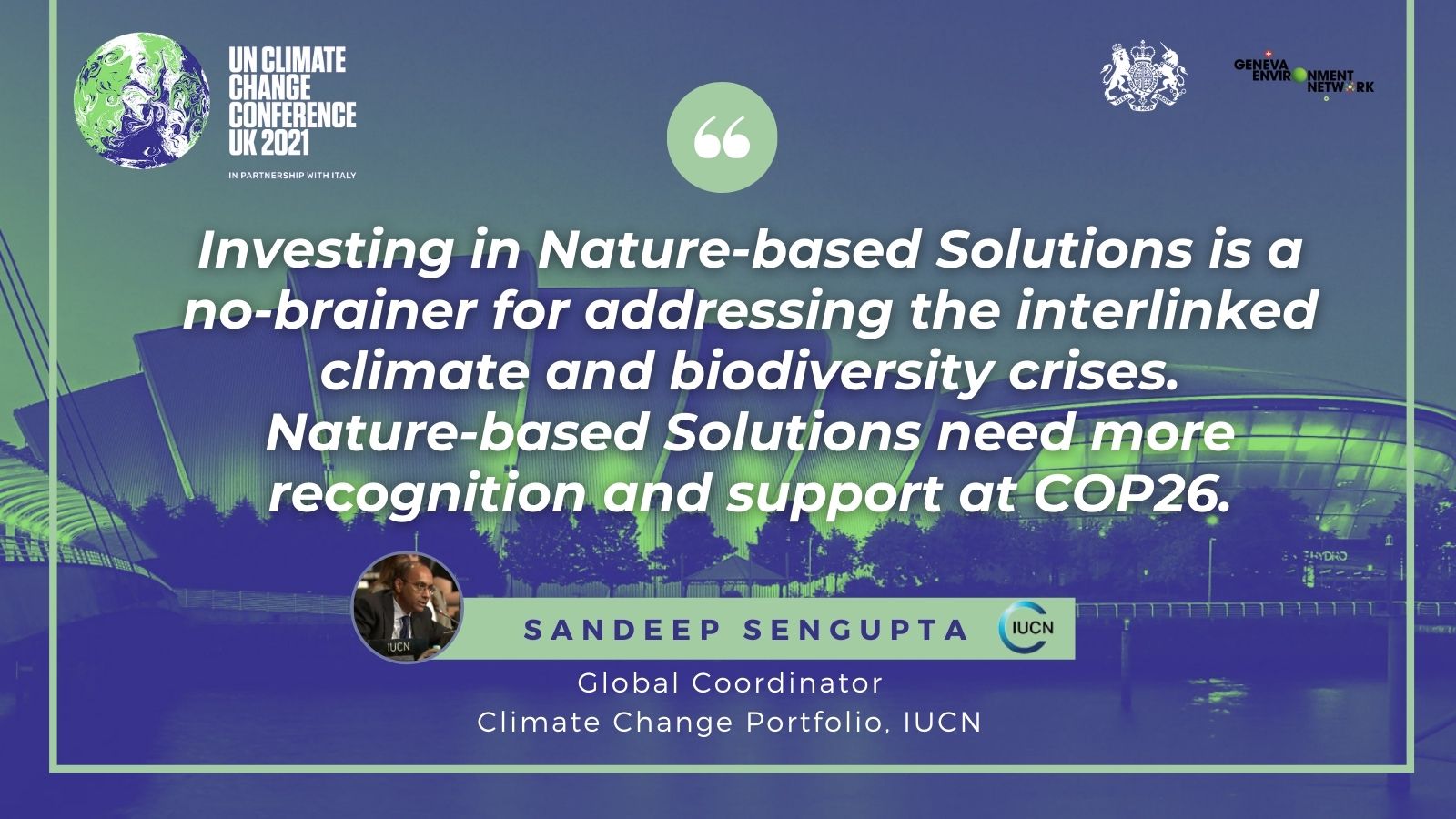
- We are currently in the midst of a serious health and climate emergency, but there is another looming crisis facing us today, that of nature and biodiversity loss. As our members reminded us last month at the IUCN World Conservation Congress in Marseille, which was kindly hosted by France, nature and climate emergencies are not two separate crises. They are deeply interlinked.
- Climate change is a major threat to the natural world. IUCN has now identified climate change as the biggest threat to natural world heritage sites, the iconic treasures that we have on Earth. The loss and degradation of nature itself is also a major driver of climate change. The land sector, for example, contributes to over 20% of the total global emissions.
- The three messages we want to highlight at COP26 emerged from the Marseille Manifesto that was adopted at our recent congress. First, there is a big mismatch between what science is telling us is needed to limit warming to below 1.5°C and what countries are currently aiming for. More ambitious NDCs and long-term strategies are critical for addressing the climate and biodiversity crises and for achieving all the SDGs. Second, investing in nature-based solutions addresses the interlinked climate and biodiversity crises based on the conservation, restoration and sustainable management of the world’s lands and ecosystems. Nature-based solutions can provide around 30% of the total mitigation needed by 2030 to achieve the Paris Agreement temperature goal. At the same time, they can provide important benefits for adaptation, disaster-risk reduction, job creation, food and water security, and poverty reduction. Mangroves alone provide over USD 65 billion in flood protection each year and safeguard 15 million people across the world against flooding while also sequestering carbon. Third, nature-based solutions need more recognition and support at COP26. We have been working on this topic for over a decade with a clear definition and global standard.
- This year, nature-based solutions featured prominently in the environment and climate ministerial communiques of the G7 and G20 Summits. An increasing number of countries have also begun to explicitly incorporate nature-based solutions within their NDCs.
- What would be useful at COP26 is a formal decision text that clearly recognizes and supports the enhanced implementation of nature-based solutions in line with the best international standards and guidance available. This would help to operationalize the decision text on nature that parties agreed to at COP25 in Madrid and enable the unlocking of its full potential.
- Despite providing around 30% of the climate solution, nature-based solutions receive only around 3% of climate financing today. However, with everyone’s support, we hope that we will be able to scale this up in the future. Nature-based solutions can also deliver their magic only in the context of deeper decarbonization of the world economy and that should not be forgotten.
Business Commitment
- María MENDILUCE | Chief Executive Officer, We Mean Business
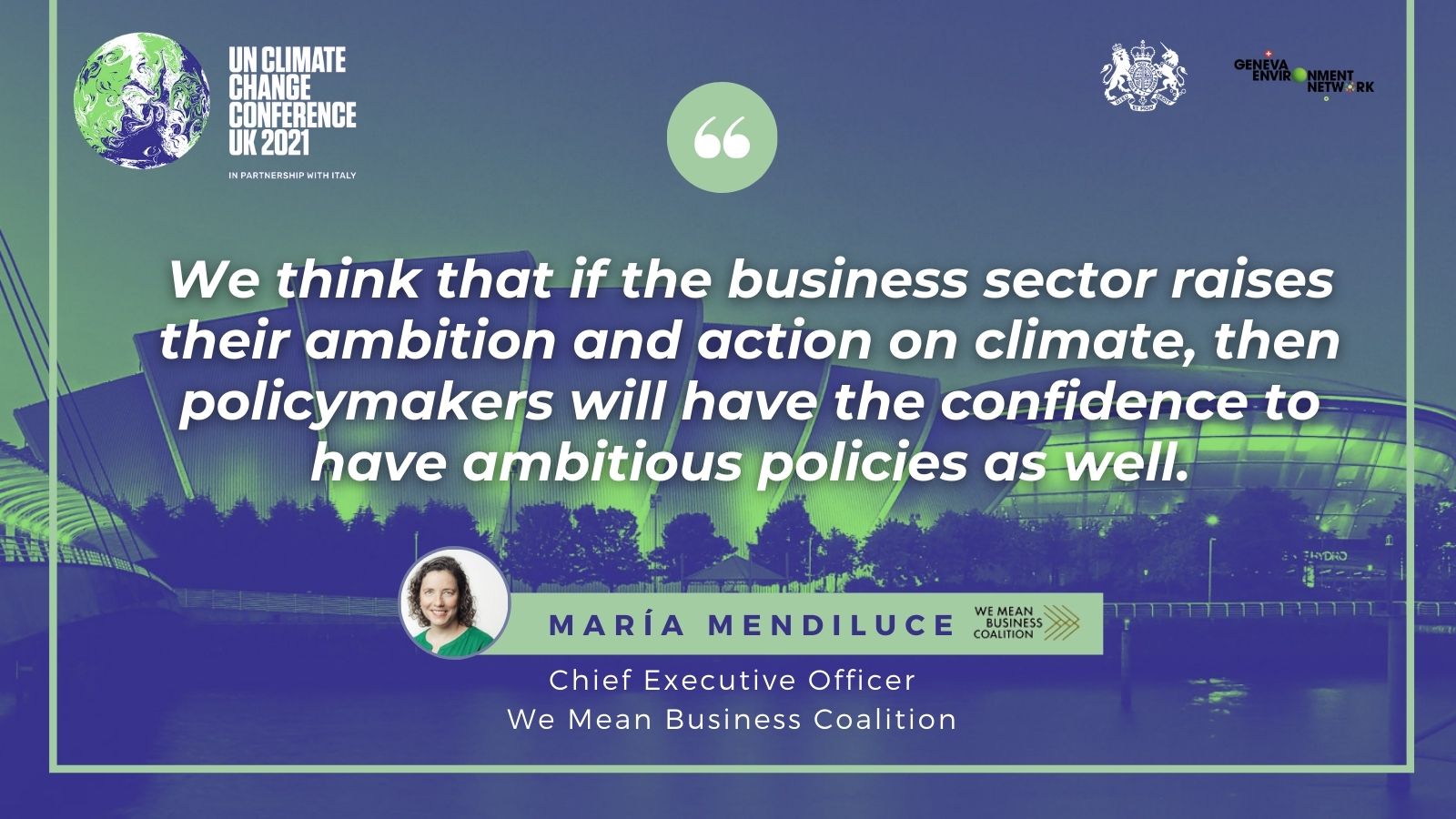
- If the business sector raised their ambition and action on climate, policy makers will have the confidence that they can have ambitious policies. We have sent a letter to G20 countries and around 800 businesses. It had 165 signatories from the UK, 150 from the US, 13 from Italy, and around 150 more from Europe. We also have a campaign for companies that are committed to net zero, aligned with the 1.5°C scenarios.
- With around 1.000 companies, of which 232 are from the UK, 155 from the US, 11 in Italy and 330 in Europe, the most ambitious NDCs come from the UK, the US and Europe, indicating that the UK and European governments have the confidence from business leaders, big multinationals, to achieving 1.5°C.
- We Mean Business tells companies that to be a climate leader, they need to do four things. First, commit to ambitious targets and we have a very interesting initiative we co-founded with other partners using science-based targets. Second, we are encouraging SMEs because we believe that we should not leave anyone behind. We have a specific program, the SME Climate Hub, we launched last week and we have 2,500 SMEs that have committed to being net zero and we want to raise capacity building. Companies also need to act. It’s not enough to have a vision, they need to act and collaborate. Third, companies need to be consistent in their advocacy. It doesn’t work that they say that they’re going to do something and then lobby for something else. Companies are under increasing scrutiny so consistency is key. They need to map where they are active and if they are not aligned with what the trade associations are doing, either they change those views or they leave that organization. Fourth, for accountability companies need to report progress. We support mandatory disclosures and their reporting progress. Once you measure and have targets, companies outperform those targets. It’s good for peers and competitors so we can have a clear framework for companies.
- We’re working with 2,000 leading companies and there are millions of companies out there. For COP26, we have very similar tasks to policy makers. We need to keep the 1.5°C messaging and let’s fix Article 6. I’m also a supporter of nature-based solutions. At the moment, the only way for companies to invest on nature is through net-zero targets. With decarbonization, let’s also invest in nature. Article 6 will help many companies invest and make that tangible targets.
Financing Climate Action
- Eric USHER | Head, UN Environment Programme Finance Initiative

- The public finance commitment of USD 100 billion is critical and is a very important piece of the puzzle which needs to be met both in terms of financing needs and global equity. However, we also have to keep in mind that we need about USD 4 trillion dollars a year just for mitigation actions. That’s 40 times the 100 billion so it points to the fact that that 100 billion is needed. It also needs to be catalytic in terms of mobilizing the private sector.
- Most of that investment is going to have to happen in developing countries, a large proportion of it, and this does not include financing for adaptation and resilience. The challenge is massive. The private finance community has made recent calls for increases in public finance and for increased government ambition.
- At COP21, a program called the task force for climate-related financial disclosures to define how the private sector should start being transparent in terms of disclosing on climate risks. They delivered a set of recommendations in 2017 and since then there has been quite significant uptake. Most large corporations today disclose on climate risk, mostly voluntary. However, the depth is not sufficient.
- The quality of started to move towards mandatory disclosures, and this is where the public sector comes in. We believe this is the way it should happen. The private sector should voluntarily lead in and, if it’s not enough, the public sector should start to mandate and regulate. The European Central Bank, the Bank of England, the Bank of Japan and others are starting to integrate it into how they function, including supervisory functions for actors in the financial sector.
- In terms of increasing the quality of such disclosures, we have to understand that, in terms of banks, very large organizations typically manage risks. It’s a big part of their responsibility. But managing climate risk is a very complicated task. It needs prediction, scenario analyses and stress testing. It’s a big change. There is progress but just being transparent doesn’t necessarily move the capital to the places it needs to go.
- At UNEP, we have been convening a number of large net-zero alliances which have sprung up under the umbrella of the Glasgow financial alliances for net zero. The first was launched in 2019. At the UN Summit in September, a group of asset owners – insurers and pension funds – made a commitment to net zero by 2050. Since then we have groups of insurers, banks and others in the financial sector running alongside in parallel.
- Banks are intimately integrated into the economy. Particularly in the developing world, most financing comes via the banks. Therefore, decarbonizing banks is very much akin to decarbonizing the economy. The Net-Zero Banking Alliance started in April and has already grown to 76, mostly very large banks. More will be announced shortly. It’s already over a third of the global banking industry, in terms of fund financing, that have committed to net-zero targets. The requirements are very specific and what they need to do is somewhat maybe akin to the Paris Handbook for governments.
- They need to align with scientific based scenarios and we need to align today with the reductions required. It should also really be about decarbonizing different sectors over the next 12 months. Most of the banks, the ones that joined early on, will issue their interim targets for all major emitting sectors for 2030. They are the 10 largest banks in Europe and the nine largest banks in North America. It also includes seven out of the 10 largest in Latin America, three out of 10 in Asia and more. But it also includes a number of developing country banks – the largest in Kenya, Egypt, Morocco, Mexico and Brazil.
- Big banks finance the economy and they’ve set their eyes on net zero. What they need to get there is to set commitments, be accountable and follow through. The Net-Zero Asset Owner Alliance who were the first and have been running for two years issued their progress report yesterday. They’ve now issued their 2025 targets which are aligned with science. In the next four years, they’ve also issued statements around the core phase-out of the use of carbon offsets. Things are happening, sending important signals from across the spectrum.
- Policy signals are also critically important and I want to congratulate Italy for the presidency of the G20. There was a sustainable finance study group that went into a deep freeze for a couple years and the Italian presidency reestablished the study group, elevated it into a working group, and just recently issued a five-year road map for what the sustainable finance working group is going to work on. It’s very ambitious and this is what the financial sector really looks to, the signals that they need to actually start to implement, and, hopefully we will see that happening at COP26.
Key Expectations for COP 26 from a Civil Society Perspective
- Joie CHOWDHURY | Program Coordinator, Environment & ESCR, International Network for Economic, Social and Cultural Rights
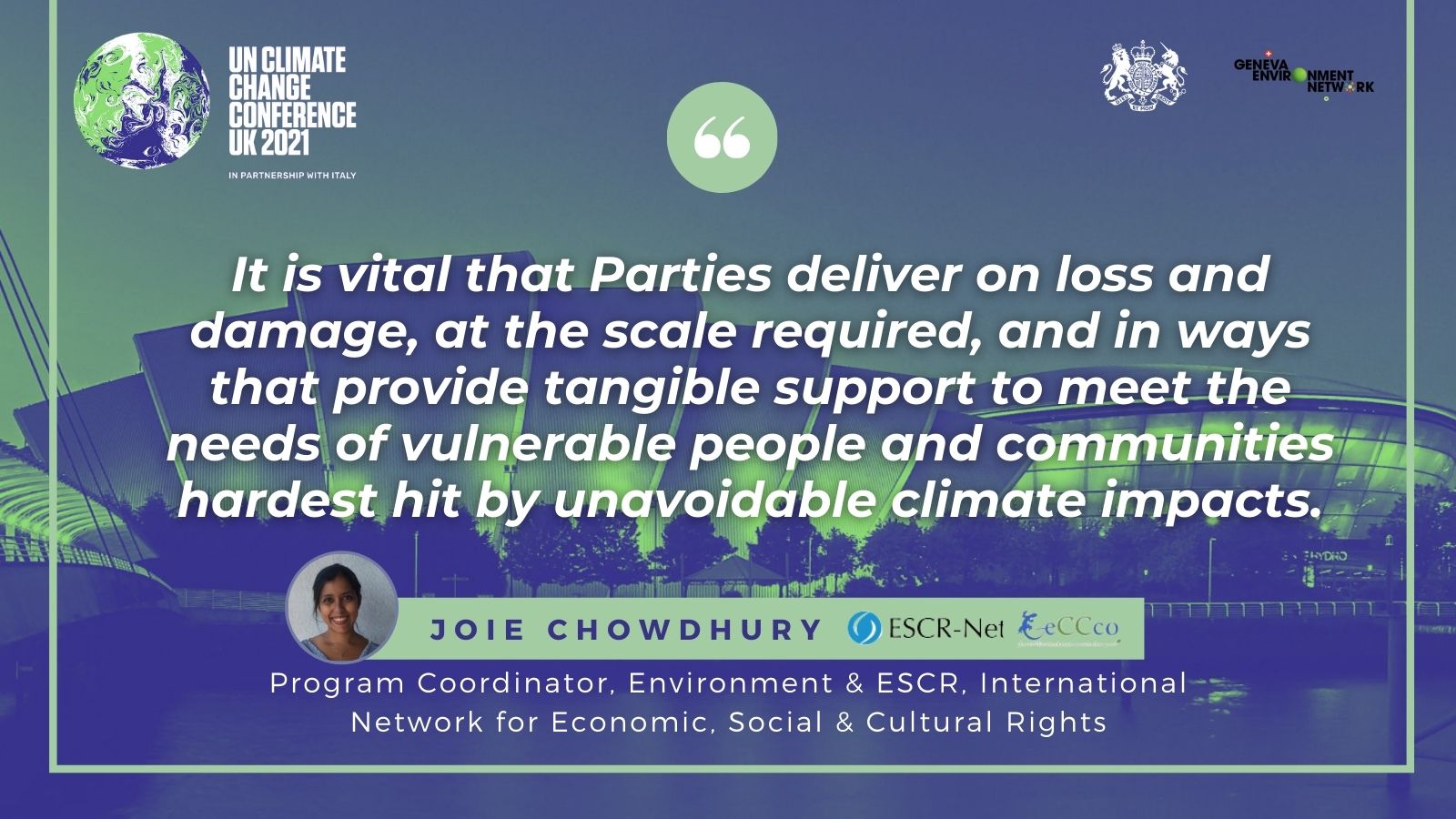
- We have the reality that environmental human rights defenders who are under unprecedented attack. Many are murdered. In terms of key expectations and demands for COP26 from a civil society perspective, we agree with many that without the fulfillment of human rights domestically and extraterritorially, we cannot advance effective climate action.
- The commitment to human rights is embedded in the Paris Agreement and must be central in all aspects of decisions taken at COP26. Effectively and urgently addressing loss and damage is a human right and climate justice is imperative. The lack of commitment of the Parties so far to address at sufficient scale the impacts and injustices of loss and damage is causing immense human suffering.
- At COP26, it is vital that Parties take proportionate actions to deliver on loss and damage at the scale required and in ways that urgently provide tangible support to meet the needs of vulnerable people and communities hardest hit by unavoidable climate impacts. This includes the provision of new and additional finance for loss and damage. Parties must also meet the existing climate finance commitments. We also expect the full and rice compliant operationalization of the Santiago Network. The mitigation gap continues to be a concern from a human rights perspective. Parties, especially G20 countries, must submit new or updated human rights NDCs consistent with the 2030 targets, which are aligned with the 1.5°C.
- We also call on Parties to ensure human rights in Article 6. We have seen previous market-based mechanisms developed under the UNFCCC that failed to deliver emission reductions, lead to violations of the human rights of indigenous peoples and local communities, in particular, land rights. Such mechanisms create a commitment environment for big polluters to delay and distract from reducing their own emissions. Parties must provide rules that prohibits the inherent faults of market instruments observed so far.
- It is critically important to ensure that all Article 6 activities respect, promote and consider human rights and the rights of indigenous peoples, including the integration of rights-based social and environmental safeguards. These elements must not be overlooked in the rush to adopt rules. Without them, there is a very real risk of undermining the Paris Agreement.
- Nature-based solutions are important but civil society is also concerned that they remain somewhat ill-defined. It’s worth noting that some of the most vocal supporters include industries and governments responsible for much of the historical and ongoing damage to the planet. Without clarity and safeguards, they can lead to human rights violations, including forced evictions from lands and territories. We call for ecosystem-based approaches in full compliance with human rights, including the rights of indigenous peoples. While such solutions are important, they must not allow big polluters to simply offset continuing emissions.
Fixing Our Climate: Green Hydrogen Initiative
- Vaitea COWAN | Co-Founder, Enapter – Earthshot Prize Winner (“Fix Our Climate”)

- As one of the winners of the Earthshot Prize, I come from an island and have a very personal connection to climate change. Since my family is threatened by the sea-level rise, I’m adopting clean solutions. They can happen out of idealism but they must also become the most economically attractive solution, and this is what we will do.
- By making the most cost-effective electrolyzer adopter designs, we paint the picture on why we need green hydrogen. It’s an alternative fuel that can end our reliance on fossil fuels in sectors like mobility, heating, and cooling. Today, 20% of our global energy consumption is met by electricity. Renewables such as solar and wind are doing a great job at driving down the cost of green electricity but we can drive down the cost of green hydrogen thanks to our core technology.
- Our technology doesn’t rely on any rare metals to achieve high performance. It is also made to work with renewables, adapting to variability without any problems. We are combining the best of the available technologies out there which means high performance with low cost. We have a unique technology but we also have a unique approach.
- When we look at economic history, we have seen the most rapid cost reduction is through mass-produced commodities. We believe that now is the time for green hydrogen. At the moment, electrolyzers are developed as a projects, requiring not only sophisticated engineering and planning but also difficult to scale up. We are standardizing and mass producing one of these core stacks that are integrated in our kilowatt standardized electrolyzer. By mass producing this core stack, we can drive down the cost of green hydrogen to compete with fossil fuels by the mid of the decade.
- Our customers are using them to refuel cars, planes, drones, and snowmobiles. They are also used in combination with solar panels and direct air capture technology. In Australia, our partners have combined hydrogen with carbon dioxide to create green methane so our electrolyzers can also be used to create synthetic fuels whether it is green ammonia or green methane hydrogen. They are also fantastic for long-term energy storage. Our electrolyzers are used to provide seasonal storage where snow is covering the solar panels. Our electrolyzers are also generating green hydrogen that is injected into a natural gas infrastructure to provide heat to nearby apartments via a hydrogen boiler.
- The use for green hydrogen is endless. The Earthshot Prize will support us. We need modular electrolyzers to flexibly produce hydrogen on site whenever solar and wind are available. The time is now and the window is still open so we need to phase out fossil fuels and commit to green hydrogen as one of the solutions.
Discussion
At the Venice Conference in July, it was observed that despite the growth of international agreements over the last 30 years, the rate of decarbonization has remained unchanged. How can COP26 change this very dangerous statistics and what could be the reasons behind it? Could you give us an update on how do you see the issue of loss and damage being tabled and negotiated at COP26 and how can we support you to have a good decision on loss and damage to drive that agenda forward? How do we leverage finance for loss and damage? How can COP26 recognize explicitly the challenge that we face in relation to fossil fuels and fossil fuel subsidies?
Ovais Sarmad: Reflecting on the loss and damage in the Santiago Network, that is something that is one of the unfinished businesses. It is high on the agenda and what needs to happen and how it can be helped is to provide very clear messages in terms of what are your expectations. The need for the governance of loss and damage is something that needs to be concluded. There are interlinkages with finance, with the current markets, with the transparency and reporting formats, and so on. It is very high on the agenda we are very much aware of it. Our Secretariat is working very closely with the key negotiators on the loss and damage and our colleagues in the adaptation unit are fully aware of the importance. I’m cautiously optimistic that a package of decisions will be taken at the top.
H.E. Amb. Simon Manley (UK): For decarbonization, it’s absolutely at the heart of what we’ve been trying to do at the G7 presidency over the course of this year. It’s absolutely at the heart of what we hope to achieve in Glasgow. We know what we need to do in terms of enabling the transition and we just need to do it. We’ve tried to do our bit by restricting financing of coal power stations overseas. There is a need to be inclusive and collaborative. In Glasgow, we want to see an ambitious agreement, a balanced agreement.
H.E. Amb. Gian Lorenzo Cornado (Italy): We have to work together in order to grant the best success in Glasgow and we need to have the involvement of the entire international community. There’s no one country that can lead this process. We don’t want to have to leave anyone behind so we need to support the poorest countries of the world. This is why it’s so important to mobilize USD 100 billion by 2025 in favor developing countries. This is essential to help them to fight and address climate change. We are also talking about loss and damage, about the countries more directly affected by climate change. I know what it means to live in a land which is only one meter tall and when major storms occur, waves go from one side to the other of the island. It is a real problem which can provoke migrations, people forced to leave their lands because of climate change. Glasgow is an historic event because the challenge is enormous. But we can make it all together. It’s a joint global planetary effort we have to promote and we have to believe in ourselves.
Eric Usher: We’ve heard reference to the production gap report that just come out in recent days pointing out the obvious inconsistency between NDCs and the fact that governments still have production plans that are double what would allow us to stay within the 1.5°C trajectory. There’s an inconsistency there. If you look at the financial sector, there is a lot of criticism of different financial actors, particularly the big banks. But if you look at what form of financing is happening in the financial sector, the banks have actually stopped or they’ve curtailed their lending significantly to these sectors. They realize it’s a bad and it doesn’t make sense. However, what the banks still do is help in the capital markets, help companies raise money where the banks don’t actually have the risk. Someone else is buying the bond or the stock in the capital markets and there they have not yet curtailed their facilitation. Part of the reason is because it’s still legal, it’s very remunerative and someone is buying. As long as it’s legal, somebody’s going to do it. Voluntary leadership from different parts of the private sector is very important to get things started but unless you have the internalization of these costs that makes them non-economic, we can’t wishfully think that these things won’t get dug up. It needs combined responsibility between the public and private sectors. A lot of it has to do with the policy signals. Fossil fuel subsidies are the most obvious inconsistency that need to be addressed.
Maria Mendiluce: In terms of fossil fuel subsidies, we think that this need to be avoided. It’s nonsense. We need to price externalities and not give them subsidies. It’s about countries committing to do it, the private sector cannot do it. In terms of green hydrogen, I love the project, congratulations! The current high energy prices together with the high carbon prices provide an incentive for these technologies to be scaled up. In addition to the Earthshot Prize, I think commitments from companies to buy those electrolyzers is what will help them in scaling up. I also think that we need to invest in infrastructure to bring renewable offshore, such as wind, to the places where green can be created. It is an energy storage solution that is needed for our future and will avoid so much volatility and political pressure.
Vaitea Cowan: I would definitely start by recommending to stop subsidizing fossil fuels. This is the biggest thing that needs to change because we cannot compete when the playing field is not levelized. It’s impossible for us to compete with artificially low prices from fossil fuels. Our technology will not require any subsidies or any external support. We know that our core technology will drive down the cost on its own but there are still many things that we are not controlling.
Closing
In November, the UK and Italy will host an event that many believe is the last chance to fix our climate. For nearly three decades, maybe even more, the UN, including UNEP, have been bringing together countries around the issue of climate change. The UNFCCC, COP26, will be held in Glasgow this year. One of the global priorities is climate change, part of the triple planetary crises that we are facing together with pollution and biodiversity. The time for action is now and we’ve got great hopes for COP26 to limit climate change to 1.5°C agreed in the Paris Agreement. The richness of the interventions and questions demonstrate that there is a willingness in Geneva to see COP26 succeed and to bring the results of COP26 to the debates here in Geneva so that we can mobilize actions around the outcomes. We can transform this ambition into action and we all have a role to play in this city to deliver the outcomes.
Video
In addition to the live WebEx and Facebook transmissions, the video will be available on this webpage.
Gallery
© UNEP, Harvey Parafina
© UK Mission Geneva, Matthieu Guillier
Documents
- Invitation
- Presentations
- AR6 Climate Change 2021:The Physical Science Basis
- 2021 Production Gap Report


